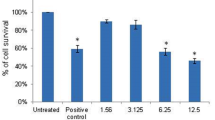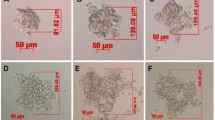Abstract
Breast cancer is among the leading causes of death due to cancers around the globe. Current therapeutic approaches towards healing of breast cancer have been associated with poor outcomes. Graphene and its derivatives have a two-dimensional flat structure, which is characterized by the ability to carry drugs and modify the surface, low cytotoxicity, and high biocompatibility. This study was performed on MCF7 and BT474 human breast cancer cells. Different concentrations of doxorubicin (DOX), graphene oxide (GO), and graphene oxide plus doxorubicin (GO-DOX) were subjected to both cell lines at specified intervals. At the end of the treatments, MTT test was applied to determine the viability of cells, and then flow cytometry, colony formation, and spheroid tests were implemented in both cell lines treated with DOX, GO, and GO-DOX components. We used DLS and TEM to confirm the GO properties. According to the MTT test results, 1 μL of DOX at 10 mg/ml (equivalent to 0.1 mg/ml) caused 50% survival of MCF7 cells at 24 h. In both cell lines, an increase in apoptosis occurred after incubation with GO and DOX. Although a rate of mortality of MCF-7 cells was due to necrosis, the BT474 cell death was merely through the apoptosis. Furthermore, the results of the colony formation test outlined an enhancing inhibitory effect in the presence of GO-DOX as a comparison to the control. Additionally, spheroids formed following treatment with GO-DOX exhibited a significant decrease compared to their control group, with an increase in the number of spheroids in BT474 cells compared to those in the MCF-7. The decreasing effect of compounds against the migration and cell invasion potential was also observed, being higher in MCF7 than BT474 cells. The effects of cytotoxic GO were observed at higher concentrations.










Similar content being viewed by others
Availability of Data and Materials
Not applicable.
References
Bertram, J. S. (2000). The molecular biology of cancer. Molecular Aspects of Medicine, 21(6), 167–223.
Vineis, P., & Wild, C. P. (2014). Global cancer patterns: Causes and prevention. The Lancet, 383(9916), 549–557.
Ehsanfar, P., Teimouri, M., & Pooladi, M. (2020). Investigating characterizations and antifungal effects of solid lipid nanoparticles (SLNs) loaded with essential oil of Citrus Aurantifolia on isolated Malassezia strains. Archives of Advances in Biosciences, 11(3), 43–55.
Telli, M. L., Gradishar, W. J., & Ward, J. H. (2019). NCCN guidelines updates: Breast cancer. Journal of the National Comprehensive Cancer Network, 17(5.5), 552–555.
Teimouri, M., & Pooladi, M. (2021). Anti-angiogenic and anti-proliferative effects of Physalis alkekengi hydroalcholic extract on breast cancer in mice. Journal of Fasa University of Medical Sciences, 10(4), 1–8.
Howell, A., Cuzick, J., Baum, M., Buzdar, A., Dowsett, M., Forbes, J. F., Hoctin-Boes, G., Houghton, J., Locker, G. Y., & Tobias, J. S. (2005). Results of the ATAC (Arimidex, Tamoxifen, alone or in combination) trial after completion of 5 years’ adjuvant treatment for breast cancer. Lancet, 365(9453), 60–62.
Navya, P. N., Kaphle, A., Srinivas, S. P., Bhargava, S. K., Rotello, V. M., & Daima, H. K. (2019). Current trends and challenges in cancer management and therapy using designer nanomaterials. Nano Convergence, 6(1), 23.
Lim, E. K., Kim, T., Paik, S., Haam, S., Huh, Y. M., & Lee, K. (2015). Nanomaterials for theranostics: Recent advances and future challenges. Chemical Reviews, 115(1), 327–394.
Duran, N., Martinez, D., Silveira, C., Duran, M., de Moraes, A., Simoes, M., Alves, O., & Favaro, W. (2015). Graphene oxide: A carrier for pharmaceuticals and a scaffold for cell interactions. Current Topics in Medicinal Chemistry, 15(4), 309–327. https://doi.org/10.2174/1568026615666150108144217
Jiang, J. H., Pi, J., Jin, H., & Cai, & J. Y. . (2018). Functional graphene oxide as cancer-targeted drug delivery system to selectively induce oesophageal cancer cell apoptosis. Artificial Cells Nanomedicine, and Biotechnology, 46(sup3), S297-307.
Qin, X. C., Guo, Z. Y., Liu, Z. M., Zhang, W., Wan, M. M., & Yang, B. W. (2013). Folic acid-conjugated graphene oxide for cancer targeted chemo-photothermal therapy. Journal of Photochemistry and Photobiology B: Biology, 120, 156–162.
Kumar, S., Srivastava, S., Yadav, B. K., Lee, S. H., Sharma, J. G., Doval, D. C., & Malhotra, B. D. (2015). Reduced graphene oxide modified smart conducting paper for cancer biosensor. Biosensors and Bioelectronics, 73, 114–122.
Zhang, L. N., Deng, H. H., Lin, F. L., Xu, X. W., Weng, S. H., Liu, A. L., Lin, X. H., Xia, X. H., & Chen, W. (2014). In situ growth of porous platinum nanoparticles on graphene oxide for colorimetric detection of cancer cells. Analytical Chemistry, 86(5), 2711–2718.
Wang, F., Sun, Q., Feng, B., Xu, Z., Zhang, J., Xu, J., Lu, L., Yu, H., Wang, M., Li, Y., & Zhang, W. (2016). Polydopamine-functionalized graphene oxide loaded with gold nanostars and doxorubicin for combined photothermal and chemotherapy of metastatic breast cancer. Advanced Healthcare Materials, 5(17), 2227–2236.
Yang, D., Feng, L., Dougherty, C. A., Luker, K. E., Chen, D., Cauble, M. A., Holl, M. M., Luker, G. D., Ross, B. D., Liu, Z., & Hong, H. (2016). In vivo targeting of metastatic breast cancer via tumor vasculature-specific nano-graphene oxide. Biomaterials, 104, 361–371.
Muzyka, R., Kwoka, M., Smędowski, Ł, Díez, N., & Gryglewicz, G. (2017). Oxidation of graphite by different modified Hummers methods. New Carbon Materials, 32(1), 15–20.
Jiang, G., Lin, Z., Chen, C., Zhu, L., Chang, Q., Wang, N., & Tang, H. (2011). TiO2 nanoparticles assembled on graphene oxide nanosheets with high photocatalytic activity for removal of pollutants. Carbon, 49(8), 2693–2701.
Teng, C. Y., Yeh, T. F., Lin, K. I., Chen, S. J., Yoshimura, M., & Teng, H. (2015). Synthesis of graphene oxide dots for excitation-wavelength independent photoluminescence at high quantum yields. Journal of Materials Chemistry C, 3(17), 4553–4562.
Teng, C. Y., Nguyen, B. S., Yeh, T. F., Lee, Y. L., Chen, S. J., & Teng, H. (2017). Roles of nitrogen functionalities in enhancing the excitation-independent green-color photoluminescence of graphene oxide dots. Nanoscale, 9(24), 8256–8265.
Fiorillo, M., Verre, A. F., Iliut, M., Peiris-Pagés, M., Ozsvari, B., Gandara, R., Cappello, A. R., Sotgia, F., Vijayaraghavan, A., & Lisanti, M. P. (2015). Graphene oxide selectively targets cancer stem cells, across multiple tumor types: Implications for non-toxic cancer treatment, via “differentiation-based nano-therapy.” Oncotarget, 6(6), 3553.
Yoon, H. J., Kim, T. H., Zhang, Z., Azizi, E., Pham, T. M., Paoletti, C., Lin, J., Ramnath, N., Wicha, M. S., Hayes, D. F., & Simeone, D. M. (2013). Sensitive capture of circulating tumour cells by functionalized graphene oxide nanosheets. Nature Nanotechnology, 8(10), 735–741.
Kim, H. W., Yoon, H. W., Yoon, S. M., Yoo, B. M., Ahn, B. K., Cho, Y. H., Shin, H. J., Yang, H., Paik, U., Kwon, S., & Choi, J. Y. (2013). Selective gas transport through few-layered graphene and graphene oxide membranes. Science, 342(6154), 91–95.
Yang, K., Wan, J., Zhang, S., Tian, B., Zhang, Y., & Liu, Z. (2012). The influence of surface chemistry and size of nanoscale graphene oxide on photothermal therapy of cancer using ultra-low laser power. Biomaterials, 33(7), 2206–2214.
Ku, S. H., & Park, C. B. (2013). Myoblast differentiation on graphene oxide. Biomaterials, 34(8), 2017–2023.
Alibolandi, M., Mohammadi, M., Taghdisi, S. M., Ramezani, M., & Abnous, K. (2017). Fabrication of aptamer decorated dextran coated nano-graphene oxide for targeted drug delivery. Carbohydrate Polymers, 155, 218–229.
Sasidharan, A., Swaroop, S., Chandran, P., Nair, S., & Koyakutty, M. (2016). Cellular and molecular mechanistic insight into the DNA-damaging potential of few-layer graphene in human primary endothelial cells. Nanomedicine: Nanotechnology, Biology and Medicine, 12(5), 1347–1355. https://doi.org/10.1016/j.nano.2016.01.014
Chatterjee, N., Eom, H. J., & Choi, J. (2014). A systems toxicology approach to the surface functionality control of graphene–cell interactions. Biomaterials, 35(4), 1109–11027.
Yuan, Y., Gao, X., Wei, Y., Wang, X., Wang, J., Zhang, Y., & Gao, C. (2017). Enhanced desalination performance of carboxyl functionalized graphene oxide nanofiltration membranes. Desalination, 405, 29–39.
Dutta, T., Sarkar, R., Pakhira, B., Ghosh, S., Sarkar, R., Barui, A., & Sarkar, S. (2015). ROS generation by reduced graphene oxide (rGO) induced by visible light showing antibacterial activity: Comparison with graphene oxide (GO). RSC Advances, 5(98), 80192–80195.
Ordikhani, F., Farani, M. R., Dehghani, M., Tamjid, E., & Simchi, A. (2015). Physicochemical and biological properties of electrodeposited graphene oxide/chitosan films with drug-eluting capacity. Carbon, 84, 91–102.
Chen, J., Wang, X., & Han, H. (2013). A new function of graphene oxide emerges: Inactivating phytopathogenic bacterium Xanthomonas oryzae pv Oryzae. Journal of Nanoparticle Research, 15(5), 1–4.
Chang, Y., Yang, S. T., Liu, J. H., Dong, E., Wang, Y., Cao, A., Liu, Y., & Wang, H. (2011). In vitro toxicity evaluation of graphene oxide on A549 cells. Toxicology Letters, 200(3), 201–210.
Arya, N., Arora, A., Vasu, K. S., Sood, A. K., & Katti, D. S. (2013). Combination of single walled carbon nanotubes/graphene oxide with paclitaxel: A reactive oxygen species mediated synergism for treatment of lung cancer. Nanoscale, 5(7), 2818–2829.
Hu, X., Ouyang, S., Mu, L., An, J., & Zhou, Q. (2015). Effects of graphene oxide and oxidized carbon nanotubes on the cellular division, microstructure, uptake, oxidative stress, and metabolic profiles. Environmental Science & Technology, 49(18), 10825–10833.
Vallabani, N. V., Mittal, S., Shukla, R. K., Pandey, A. K., Dhakate, S. R., Pasricha, R., & Dhawan, A. (2011). Toxicity of graphene in normal human lung cells (BEAS-2B). Journal of Biomedical Nanotechnology, 7(1), 106–107.
Chung, C., Kim, Y. K., Shin, D., Ryoo, S. R., Hong, B. H., & Min, D. H. (2013). Biomedical applications of graphene and graphene oxide. Accounts of Chemical Research, 46(10), 2211–2224.
Tadyszak, K., Wychowaniec, J. K., & Litowczenko, J. (2018). Biomedical applications of graphene-based structures. Nanomaterials, 8(11), 944.
Funding
This research was funded by the Islamic Azad University, Iran.
Author information
Authors and Affiliations
Contributions
M Pooladi and M Teimouri designed the study, dathcred and analyzed the data, and wrote the paper. M Ebrahimi and M Pooladi contributed to study design.
Corresponding author
Ethics declarations
Ethical Approval
Not applicable.
Consent to Participate
I confirm that the final manuscript has been seen and approved by all the authors. The undersigned author transfers all copyright ownership of the manuscript to the International Journal of Applied Biochemistry and Biotechnology in the event the work is published.
Consent to Publish
We hope that you will find our manuscript acceptable for publication in the above journal.
Competing Interests
The authors declare no competing interests.
Additional information
Publisher’s Note
Springer Nature remains neutral with regard to jurisdictional claims in published maps and institutional affiliations.
Rights and permissions
About this article
Cite this article
Ebrahimi, M., Teimouri, M. & Pooladi, M. The Synergistic Anticancer Traits of Graphene Oxide Plus Doxorubicin Against BT474 and MCF7 Breast Cancer Stem Cells In Vitro. Appl Biochem Biotechnol 193, 3586–3601 (2021). https://doi.org/10.1007/s12010-021-03623-8
Received:
Accepted:
Published:
Issue Date:
DOI: https://doi.org/10.1007/s12010-021-03623-8




